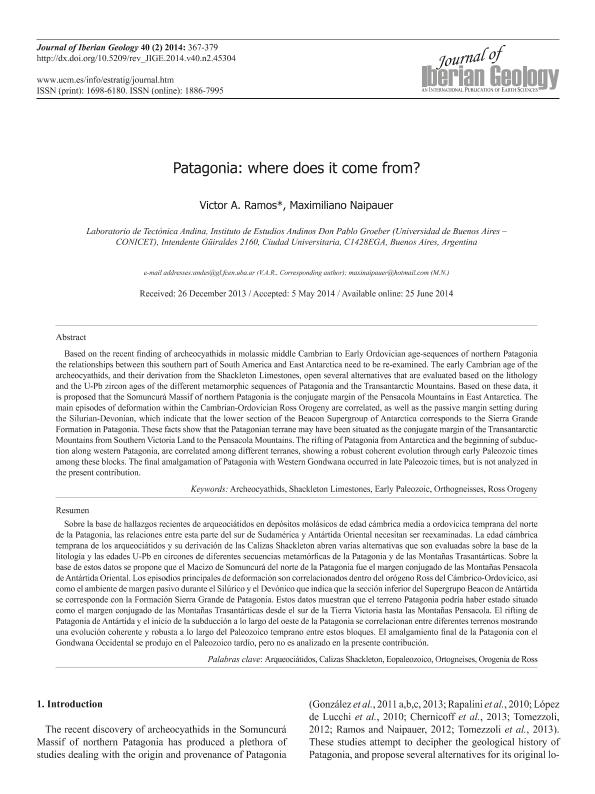Mostrar el registro sencillo del ítem
dc.contributor.author
Ramos, Victor Alberto

dc.contributor.author
Naipauer, Maximiliano

dc.date.available
2017-06-19T20:22:21Z
dc.date.issued
2014
dc.identifier.citation
Ramos, Victor Alberto; Naipauer, Maximiliano; Patagonia: where does it come from?; Universidad Complutense de Madrid; Journal Of Iberian Geology; 40; 2; -1-2014; 367-379
dc.identifier.issn
1698-6180
dc.identifier.uri
http://hdl.handle.net/11336/18481
dc.description.abstract
Based on the recent finding of archeocyathids in molassic middle Cambrian to Early Ordovician age-sequences of northern Patagonia the relationships between this southern part of South America and East Antarctica need to be re-examined. The early Cambrian age of the archeocyathids, and their derivation from the Shackleton Limestones, open several alternatives that are evaluated based on the lithology and the U-Pb zircon ages of the different metamorphic sequences of Patagonia and the Transantarctic Mountains. Based on these data, it is proposed that the Somuncurá Massif of northern Patagonia is the conjugate margin of the Pensacola Mountains in East Antarctica. The main episodes of deformation within the Cambrian-Ordovician Ross Orogeny are correlated, as well as the passive margin setting during the Silurian-Devonian, which indicate that the lower section of the Beacon Supergroup of Antarctica corresponds to the Sierra Grande Formation in Patagonia. These facts show that the Patagonian terrane may have been situated as the conjugate margin of the Transantarctic Mountains from Southern Victoria Land to the Pensacola Mountains. The rifting of Patagonia from Antarctica and the beginning of subduction along western Patagonia, are correlated among different terranes, showing a robust coherent evolution through early Paleozoic times among these blocks. The final amalgamation of Patagonia with Western Gondwana occurred in late Paleozoic times, but is not analyzed in the present contribution.
dc.description.abstract
Sobre la base de hallazgos recientes de arqueociátidos en depósitos molásicos de edad cámbrica media a ordovícica temprana del norte de la Patagonia, las relaciones entre esta parte del sur de Sudamérica y Antártida Oriental necesitan ser reexaminadas. La edad cámbrica temprana de los arqueociátidos y su derivación de las Calizas Shackleton abren varias alternativas que son evaluadas sobre la base de la litología y las edades U-Pb en circones de diferentes secuencias metamórficas de la Patagonia y de las Montañas Trasantárticas. Sobre la base de estos datos se propone que el Macizo de Somuncurá del norte de la Patagonia fue el margen conjugado de las Montañas Pensacola de Antártida Oriental. Los episodios principales de deformación son correlacionados dentro del orógeno Ross del Cámbrico-Ordovícico, así como el ambiente de margen pasivo durante el Silúrico y el Devónico que indica que la sección inferior del Supergrupo Beacon de Antártida se corresponde con la Formación Sierra Grande de Patagonia. Estos datos muestran que el terreno Patagonia podría haber estado situado como el margen conjugado de las Montañas Trasantárticas desde el sur de la Tierra Victoria hasta las Montañas Pensacola. El rifting de Patagonia de Antártida y el inicio de la subducción a lo largo del oeste de la Patagonia se correlacionan entre diferentes terrenos mostrando una evolución coherente y robusta a lo largo del Paleozoico temprano entre estos bloques. El amalgamiento final de la Patagonia con el Gondwana Occidental se produjo en el Paleozoico tardío, pero no es analizado en la presente contribución.
dc.format
application/pdf
dc.language.iso
eng
dc.publisher
Universidad Complutense de Madrid

dc.rights
info:eu-repo/semantics/openAccess
dc.rights.uri
https://creativecommons.org/licenses/by-nc-sa/2.5/ar/
dc.subject
Arqueociátidos
dc.subject
Caliza Shackletón
dc.subject
Eopaleozoico
dc.subject
Ortogneises
dc.subject.classification
Geología

dc.subject.classification
Ciencias de la Tierra y relacionadas con el Medio Ambiente

dc.subject.classification
CIENCIAS NATURALES Y EXACTAS

dc.title
Patagonia: where does it come from?
dc.type
info:eu-repo/semantics/article
dc.type
info:ar-repo/semantics/artículo
dc.type
info:eu-repo/semantics/publishedVersion
dc.date.updated
2017-06-19T17:26:48Z
dc.identifier.eissn
1886-7995
dc.journal.volume
40
dc.journal.number
2
dc.journal.pagination
367-379
dc.journal.pais
España

dc.journal.ciudad
Madrid
dc.description.fil
Fil: Ramos, Victor Alberto. Consejo Nacional de Investigaciones Científicas y Técnicas. Oficina de Coordinación Administrativa Ciudad Universitaria. Instituto de Estudios Andinos "Don Pablo Groeber". Universidad de Buenos Aires. Facultad de Ciencias Exactas y Naturales. Instituto de Estudios Andinos ; Argentina
dc.description.fil
Fil: Naipauer, Maximiliano. Consejo Nacional de Investigaciones Científicas y Técnicas. Oficina de Coordinación Administrativa Ciudad Universitaria. Instituto de Estudios Andinos "Don Pablo Groeber". Universidad de Buenos Aires. Facultad de Ciencias Exactas y Naturales. Instituto de Estudios Andinos ; Argentina
dc.journal.title
Journal Of Iberian Geology

dc.relation.alternativeid
info:eu-repo/semantics/altIdentifier/doi/http://dx.doi.org/10.5209/rev_JIGE.2014.v40.n2.45304
dc.relation.alternativeid
info:eu-repo/semantics/altIdentifier/url/http://revistas.ucm.es/index.php/JIGE/article/view/45304
Archivos asociados
